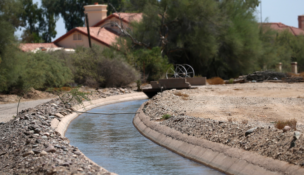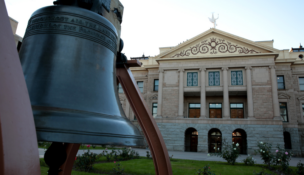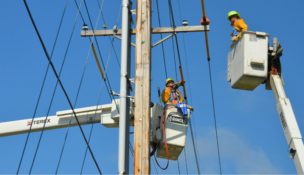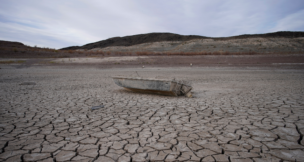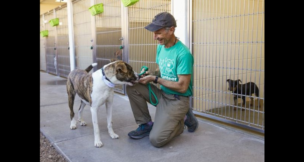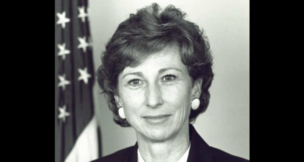Arizona’s Skull and Bones
Arizona Capitol Reports Staff//February 8, 2008//[read_meter]

Sam Layne, abandoned mine supervisor, looks over a derelict mine shaft in the desert off U.S. Highway 60 between Florence Junction and Superior. Layne said plans are underway to fill in the shaft.
It has been six months since 13-year-old Rikki Howard was killed when she plummeted down the 125-foot deep Brighter Days mine shaft in Chloride — and Joe Hart, the Arizona state mine inspector, looks tired and frustrated.
Aside from a sign and some fencing, the mine remains as open as it was on the September day when it claimed Howard’s life. Compounding Hart’s aggravation is the mid-January death of 19-year-old Tyler Halverson, who took several steps away from a nighttime campfire in Cave Creek and plunged to his death into a vertical shaft.
“We’re just about where we were during the first week of October,” said Hart, speaking of the progress made towards sealing the Brighter Days mine, which lies less than 20 miles from his hometown of Kingman. “Now it’s February and we still haven’t got this thing closed. The frustration is just maddening.”
Filling up or otherwise sealing off any one of Arizona’s estimated 100,000 inactive mines is more difficult than at first glance. Insiders blamed the lengthy process, which can take up to a year, on chronic underfunding and hard navigating through differing requirements for federal, state and privately owned lands.
Modern growth and recreation methods are tragically colliding with remnants of Arizona’s rich mining tradition. More are sure to die, Hart believes, but the damage could be limited with more money and updated laws.
Now they’re not going to do anything
To date, nobody from Hart’s office has personally spoken to Lorraine W. Prescott, whose limited liability company, Magnum Resources, owns the plot of land in Chloride where Howard died while trekking through the desert on an all-terrain vehicle.
It took weeks to simply find out who owned the land, a time-consuming process that can involve intensive research and coordination with state and federal agencies such as the Arizona Department of Mines and Mineral Resources, the U.S. Bureau of Land Management, the U.S. Forest Service and the Arizona State Land Department.
Contact began with Magnum Resources’ statutory agent on Sept. 24, when the Arizona Mine Inspector’s Office demanded the Brighter Days mine be physically secured and marked with warning signs within 60 days.
Failure to comply within the deadline is a class 2 misdemeanor, punishable by a $750 fine and up to four months in jail. The penalty, Hart said, amounts to a “slap on the wrist.”
The deadline expired with no response, and Hart leveled additional complaints against two more open mines on the property, Lucky Boy and Samoa, in early December. It was a “wake-up call,” said Hart, who campaigned on the issue of abandoned mine safety.
However, receipts of the second and third documents never surfaced, so the complaints were sent again in January, two days after Magnum Resources attorney Kevin McFadden informed the office that Prescott had left the country for “some South Pacific island.”
But McFadden also inquired whether the office could help arrange to secure a bid for a contractor to fill the open mines. Hart said he found the question very encouraging, and began the rare move of securing a contractor for a private interest.
The bomb was dropped on Jan. 15: McFadden informed the office that his firm, Brown & Arenofsky, “no longer represents Ms. Lorraine W. Prescott or Magnum Resources, Ltd. other than as statutory agent.”
The complaints, he wrote, were forwarded to Prescott.
Contacted by the Arizona Capitol Times, McFadden cited “attorney-client privilege” and refused to comment on Prescott’s whereabouts, when she left, how or why the agreement was terminated, or who currently represents the proprietor of the fatal mine.
That information has also been withheld from the office of the mining inspector, said Deputy Mine Inspector Laurie Swartzbaugh.
“I was excited,” said Hart, who calls Prescott the “mystery woman.” “I thought they really were going to be serious about closing this thing. The bid they had was very reasonable. They have three mines in that area, two of them are very dangerous — the one the girl fell in, and there is another one even closer to the road. Now they’re just not going to do anything about any of them.”
Legally, Hart has done all that current law allows when a private interest fails or refuses to make abandoned mine safeguards: he has erected an easily removable chain-link fence around the rocky portal.
I live and work in the middle of nowhere
Abandoned mine specialist Sam Layne is country, just like Hart, whose office is loaded with photos of him with music stars like Tanya Tucker, Willie Nelson, Hank Williams Jr., Waylon Jennings, and George Jones.
The resident of Superior has 30 years of mining experience and can recall the days when mining operations came to a halt in Florence Junction, where Irish, Welsh and Slavic laborers familiar with coal and iron work arrived in the late 1800s to ply their trade.
The business of digging and extracting silver ore from the area continued until the 1930s, when demand for gold and silver was replaced by wartime need for copper and lead, he said.
“At the turn of the century, there were no jobs as we know them,” said Layne. “If you could come out here and mine and make a dollar a day that was a good job.”
Layne is one of four inspectors with the Mine Inspector’s Office in the state, and despite his vast experience and familiarity with Arizona territory, he is still learning of dangerous open mine shafts — often from hunters, campers, hikers and recreational riders of all terrain vehicles.
His job keeps him right where he wants to be, “in the middle of nowhere.” In this case, he stands under the backdrop of the Superstition Mountains. Layne finds, surveys, gauges the degree of danger presented by open mines and reports his findings to the Mine Inspector’s Office.
He keeps in nearly constant contact with rock clubs, campers, off-roaders, mining companies and anybody he can use to expand his knowledge of Arizona’s mines and convey his message: stay out of abandoned mines.
He estimates he has helped seal some 400 mines in the state, and has participated in the recovery of four bodies of victims from mines among Arizona’s 73 million acres.
Layne stands above one such mine, an “orphan” whose origin is untraceable through official claims of ownership or assaying reports used to record the quality of a mine’s produced ore. It lies less than a quarter-mile from the U.S. 60, and right next to an established path used by off-roaders and hikers.
With the exception of the timber that rings the narrow mouth of the 40-feet-deep shaft, the site is virtually identical to the Cave Creek mining hole where sheriff’s deputies recovered the body of Halverson, who died after a day of dirt-biking with friends, said Layne, pointing to a fresh footprint in the loose gravel that funnels into the opening.
The easily accessible mine was reported by a javelina hunter in September. It has been scheduled for closing on Feb. 18; the delay caused by jointly held rights on the property. The state owns the surface area, while the claim to minerals held below is held by the U.S. Bureau of Land Management, Layne said.
&
ldquo;The logic is we ought to just have a little loader on a trailer we tow and fill these things in,” he said. “But you can’t. That would be ideal if we could, and boy could we expedite this. We would love to be able to, but we can’t because of all the legal issues.”
The area is littered with freshly spent and sun-beaten shotgun shells and casings of various calibers. Nearby, in a water-carved trench through rock, a broken shovel sits idly along with snapped, yet-to-be rusted pliers and a pair of suspenders. That stuff was evidence, he surmised, of a recreational gold panner.
Once located in the “boonies,” people are bumping into Arizona’s mining legacy with increasing frequency, thanks to a boost in all-terrain vehicle interest, high-dollar homes nestled in pristine deserts, and ‘drive-‘till-you-qualify’ mortgages for the significantly less affluent, Layne said.
“These mines used to be in the middle of nowhere,” he said. “Now there are million-dollar homes right next to these mine shafts.”
And just a few miles away, near a railroad filming location of the 1960s classic How the West was Won, is a larger, more frightening open mine with a 12-foot-diameter.
Fresh rains have helped vegetation sprout to the mine’s lip, and its shaded location under a Palo Verde tree make the 42-foot-deep hole nearly invisible from only several feet away.
Grumbling, Layne pulls a metal sign bearing an ominous skull and crossbones reading “WARNING DANGER! STAY OUT! STAY ALIVE!” and a 16-pound sledgehammer. He smacks the posted sign several feet into the soft ground, right where he hammered in the last one two weeks earlier.
The mine, reported in June by a hiker, is also scheduled to be filled. Another cause for the delay lies about a dozen feet away.
It’s a six-foot-long pile of rocks rises about a foot above the usual contours of the desert. A state archeologist was summoned earlier to determine if the site holds human remains, possibly a dead miner from an era known for its desperate, tough men.
That question was answered with one strike of a shovel that produced small blackened pebble-sized nuggets. It was a common, properly extinguished campfire.
Historical significance is almost the only disruption to filling in dangerous, potentially fatal mines that doesn’t seem to bother Layne. The other is biological, as some mines house thousands of creatures that hold his respect: bats, the relentless and efficient consumers of disease-carrying mosquitoes.
Hart, from his office, doesn’t seem nearly as accepting of history-related delays to mine sealing.
“Put a plaque up,” he said.
‘Looky Lous,’ ‘Curious Georges,’ blatant destruction and sheer stupidity
Theft of the attention-grabbing warning signs is rampant, and the stolen objects frequently end up for sale on the Internet, which also provides directions for enthusiasts and daredevils eager to visit Arizona’s most dangerous vertical shafts and winzes, which are horizontal adits that contain plunging vertical mine shafts.
In contrast with the misdemeanor offense for ignoring warnings from the mine inspector, vandalizing or removing signs or protective closures over mines is a class 6 felony, which earns violators a year in prison.
But deterrence is not a factor. Swartzbaugh said she is not aware of anybody ever getting caught, much less charged. Most vandalism is attributed to “Looky Lous” and “Curious Georges” intent on peeking or rummaging inside mines, she said.
Layne attests to that fact. Erected signs are stolen almost immediately. Chain links fences are snipped through or climbed over. More challenging double-layered fences equipped with sharpened military-style concertina wire are simply ripped from their moorings by trucks or winches, he said.
One such event happened in Peoria, where inspectors made the startling discovery that somebody had tied off a 100-foot length of fire hose into knots in order to descend into a deep open shaft, a decision Layne called “insane” and “about the stupidest thing I’ve ever seen.”
“All of us in the mining industry have lost friends,” he said, speaking of deaths occurring in legitimate production mining. “And to see something like that brings it (memories) all back.”
Layne attributes the curiosity generated by closed or marked mines to gold fever or useless impulses, and notes officials in Colorado claim the theft of warning signs has dropped significantly simply by affixing American flag decals.
More care taken to temporarily seal off abandoned mines only brings more attention to the sites, sometimes making doing anything a “tough call,” he said.
Legislator looks to redirect arts funding to help solve mine problem
A large amount of funding to secure mines comes from the Abandoned Mine Safety Fund, an account with no guaranteed revenue source.
Last year, Freeport McMoRan, one of the world’s largest copper mining companies, contributed $50,000 to the fund, and the Legislature matched the ante.
But it is not nearly enough, said Hart, claiming half the account has been used to fill-up 11 abandoned mines, and to mark and fence another 110.
A July study by the Western Economic Analysis Center reports that in 2006 Arizona’s copper industry had a direct and indirect economic impact of $4.7 million, generating $325 million in state and local government revenues.
The Office of the Mine Inspector was given $1.2 million to operate during the 2006 fiscal year, according to the Arizona Joint Legislative Budget Committee. For this fiscal year, the Legislature approved $1.8 million.
But considering the budget crisis, now is the wrong time for state agencies to come to the Legislature for money, said Senate Appropriations Chairman Robert Burns, a Peoria Republican.
Like Hart and Layne, Burns said he believes the mines will continue to take lives unless something is done. With S1330, he has proposed steering a portion of fees collected by the Arizona Corporation Commission into the Abandoned Mines Safety Fund.
That funding, which is levied against foreign and domestic corporations when they file annual reports, goes straight to the Arizona Commission of the Arts. Last year, it generated almost $1.6 million.
Burns expects his bill to run into some opposition, but citizens’ safety ultimately outweighs the benefit gained by the arts fund, which is only one revenue source enjoyed by the commission, he said.
“I suspect that people who support the arts aren’t necessarily going to be happy about it,” Burns said. “They’ll want the funding they are used to, but we’ve got lives involved. We’ve got two deaths in the past few months because of abandoned mines. I think that is a more critical need.”
Art director: Absolutely not
His suspicions of opposition to the bill are correct. Robert Booker, executive director of the Arizona Commission of the Arts, said his agency has already agreed without complaints to have its legislative appropriations cut by 10 percent to help the state with its budget shortfalls.
This fiscal year, the commission is operating on three funding sources: the Corporation Commission fee, a direct legislative appropriation of $2.13 million, and interest generated from a $20 million endowment approved by legislators in 1996, said Booker.
The fund goes directly to large and small art interests and helps Arizona business attract and maintain employees. In addition to appropriation cuts, redirecting the corporate funding source would cause “significant damage to communities across Arizona,” said Booker, who seriously doubts $1.5 million a year could even begin to solve the abandoned mine problem.
“If
it’s really that important, the state should back it up with a direct appropriation out of the state’s general fund,” he said. “You don’t go after a longstanding relationship out of the blue to fix a portion — a tiny portion — of the project. This tiny fix of what the corporation dollars would do for them really enables an entire arts industry across the state.”
And if the Legislature doesn’t want to step up with money, why not look to the all-terrain vehicle industry that is responsible for many of the abandoned mining accidents, he asked.
The arts director said his commission will lobby against Burns’ bill if it is heard in committee. The commission’s influential members, including Victoria Cummiskey; wife of former state senator Chris Cummiskey; Lisa Barnes, wife of former legislator and prominent lobbyist Stan Barnes; and Danita Rios, daughter of longtime lawmaker Pete Rios, will not play a factor in the bill’s defeat, he said.
Ultimately, that will occur from the “people of Arizona,” said Booker.
Pondering an upcoming political fight with arts’ interests, Hart said he is not solely focused on their funding. He needs more money from anywhere, and would be happy to receive funds from another source, he said.
So far, he has also asked the Legislature for $400,000 from the budgets of the Attorney General’s Office, the Arizona Department of Environmental Quality and the State Land Department, he said.
To help fix time-consuming interagency hurdles, he would like to see an expedited process with the State Land Department and the Department of Environmental Quality to “lighten the load from planning” and shift it to action, said Hart.
And if no additional funds will come to his office, he said, his wish-list becomes shorter: more legal protection from the attorney general, because he feels it is certain he’ll get sued by relatives of victims.
But with a consistent, increased funding stream, Hart estimates the problem of abandoned mines in Arizona could be solved within five years. That would be ideal and much easier on his conscious, he said.
“I just can’t worry about these kids falling into holes for the rest of my life,” he said.≠






